This website is supported by its readers. If you click one of my links I may earn a commission. I am also a participant in the Amazon affiliates program and I will also earn a commission from qualified purchases.
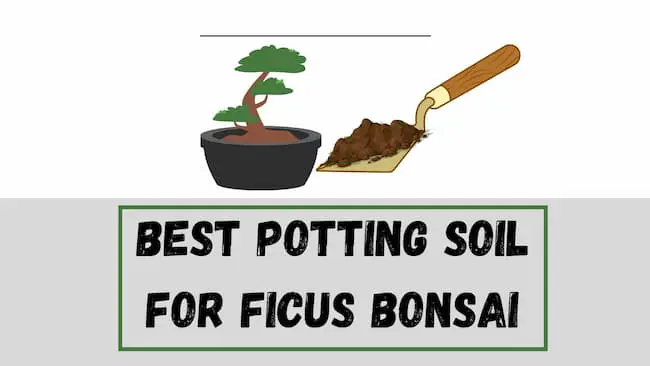
If a beginner were to ask me what the easiest bonsai tree species to grow as a beginner, I would have to say the Ginseng Ficus bonsai. It’s very easygoing, doesn’t require much care, can be kept indoors, and is incredibly beginner friendly. However, one of the most important aspects of caring for these trees is potting soil, so what is the best potting soil for Ficus bonsai?
The best potting soil for Ficus bonsai is a sandy clay soil mix. Mix 50% akadama clay, 25% pumice, and 25% volcanic ash rock for the best results. Organic soil, such as peat moss, can be added to increase the moisture of the Ficus soil.
Are there any available brands that you can purchase over the counter? And can you use traditional soil and compost for your Ficus bonsai? Keep reading to find out more!
Just a quick heads up, over the past three years of running Plantpaladin, hundreds of people have asked for product recommendations. As such, You can find my favorite indoor bonsai tree here (link takes you to Bonsaiboy), my favorite outdoor bonsai tree (link takes you to Bonsaiboy), or have a look at all the products I recommend here.
Best potting soil for Ficus bonsai?
With over 850 sub-species, it’s safe to say that Ficus trees and Ficus bonsai, in particular, are incredibly popular!
When I started growing my Ficus bonsai, I had a common question: What was the best potting soil for Ficus bonsai?
As such, I got in touch with a few experts, visited my local botanical gardens, and have since undertaken a quick survey of 10 plant paladin readers to get to the bottom of this.
To summarize:
- Inorganic sandy bonsai soil mixes are the best potting soils for Ficus bonsai.
- Typically, using 50% akadama, 25% pumice, and 25% volcanic ash will give the best properties for Ficus bonsai. You can also use this soil mix for almost every indoor deciduous bonsai, such as Chinese Elms.
- This delicate balance of sandy soil grit will allow perfect water retention, moisture flow, and aeration.
- Should you not have pumice available, gardening sand can be used as an alternative.
- Ficus bonsai trees, in particular, require moist soil to thrive, so an inorganic mix will allow the soil to remain moist in dry indoor environments.
- You can mix organic soil mixes or organic material such as peat moss soil and leaf mulch with inorganic material should you want your Ficus bonsai to absorb more water. You can then add 25% of your soil mix for organic materials.
- Ficus bonsai trees also prefer neutral soil, so it’s important to avoid soil mixes that contain heavy amounts of Sulfur, Aluminum Sulfate, or Chelated Iron which can transform the soil to become more acidic.
- You can create your potting soil significantly cheaper than purchasing store-bought bonsai soil simply by purchasing your stones and mixing them.
- While there are over 850 species of Ficus, you can use the same potting mix for most Ficus bonsai trees.
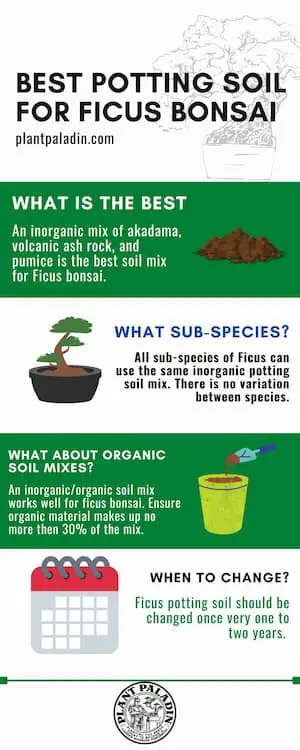
Now, this is a lot of information, so let’s explore this in a little more detail:
What is the best Ficus potting soil composition?
So what exactly is the perfect soil composition for your Ficus bonsai tree?
After all, Ficus bonsai love moist soils, especially as they are typically kept indoors where dry heated and air condition rooms can often strip away soil moisture.
On top of this, the soil needs to be neutral, which can rule out some soil material that can contaminate and make the solid more alkaline or acidic.
The best potting soil mix for Ficus bonsai is 50% akadama clay, 25% volcanic ash rock, and 25% pumice. These elements will allow for equal water retention, moisture flow, and aeration for your Ficus bonsai.
Unlike other bonsai species, such as Juniper, which prefers 100% inorganic bonsai soil, or Willow, which prefers organic bonsai soil, Ficus is unique because you can add organic material to the soil mix.
Having some organic material then will allow for extra moisture to be created in the potting soil, which can be vital should you live in a dehydrated home.
If this is the case, then I would recommend the following:
The best potting soil mix for Ficus bonsai is 25% akadama clay, 25% volcanic ash rock, 25% pumice, and 25% organic material ( such as peat soil).
You can also swap out the pumice for gardeners’ sand if the akadama clay alone isn’t retaining water.
To explain why these different elements have been selected as the best Ficus potting soil mix, I’ve created a table:
Inorganic Ficus potting soil mix details
Element | Why it is used in potting soil |
Akadama | Akadama is a clay created in Japan. Using akadama clay in your soil will ensure your tree gets all the nutrients vital to growing your bonsai. Using this, however, in a smaller percentage than 50% will ensure the tree does not become waterlogged. |
Volcanic ash rock | Is fantastic at allowing moisture to flow through. Using volcanic ash rock and pumice in even parts will ensure that your bonsai can retail and let moisture pass through your tree quickly. |
Pumice | Is a small grit-like substance. Pumice is fantastic at retaining water and will be used to retain the water in your potting soil, ensuring your tree has an ample supply of moisture. Sand can also be used. |
Top 3 picks for the best Ficus bonsai potting soil
So now we know what the best Ficus bonsai potting soil mixes are and what they contain.
What are the best picks if you want to cut to the chase and buy a store-bought brand of potting soil?
Thankfully I’ve used quite a few different varieties of potting soil on my Ficus over these past few years and have found the following three picks to be my top choice:
Best overall Ficus bonsai potting soil
For me, the best overall potting soil I’ve found has got to be easter leafs akadama volcanic ash rock mix.
This soil mix contains a nice even mix of all the vital elements required in a perfect blend, meaning you have to worry about purchasing your types of rock separately, saving you a significant amount on cost.
On top of this, it is reasonably priced and comes in various sizes, meaning it won’t break the bank.
You can read more here. (link takes you to the Eastern Leaf website)
Best cheap option
Now, if you are in a rush and want a cheap and cheerful option to use for your Ficus bonsai, then a brand I have used a few times – that I was surprised by how good the spotting soil was – was Oupengs Potting soil mix.
This, too, contains an even mix of volcanic rock needed for Ficus bonsai to thrive.
Please be aware, however, that this soil will likely need to be changed quite a bit more frequently than the others on this list.
You can grab it here. (link takes you to Amazon)

Best premium option
So, while the previous options will work well for 90% of weekend warrior bonsai owners, I recommend a premium brand if you want to take your Ficus bonsai to the next level.
For me, the All things bonsai large stone Akadama, lava, and pumice mix is the best potting soil on the market.
They opt for giant stones, which ramp up the quality of the three vital elements ( water retention, moisture flow, and aeration) on not on;y Ficus bonsai but any bonsai tree using an inorganic potting soil mix.
I have been testing this brand out recently, and I’m impressed by the results.
You can find out more about it here. (link takes you to all things bonsai’s website).
What makes up an excellent potting soil for Ficus bonsai?
So regardless of whether you decide to go for my pick, understanding what makes up an excellent potting soil for Ficus bonsai is vital.
We touched upon this earlier, but there are three key elements that all tremendous potting soil requires:
- Aeration
- Drainage
- Water retention.
Let’s explore these in more detail.
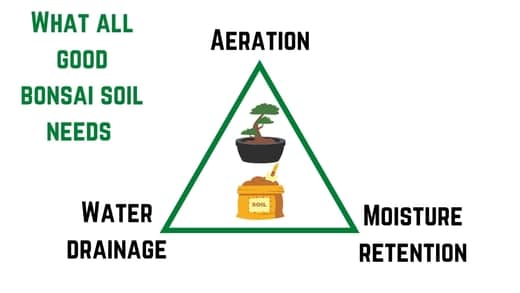
Aeration
Good aeration is the first element that all good Ficus bonsai potting soils have.
Ficus bonsai, like all trees, needs its roots to access air to help process food and grow effectively.
Failing to do so can lead to your roots becoming waterlogged and overwatered, causing root rot or fungal infections.
Good potting soil for bonsai trees will have tiny gaps and air pockets, from which your roots can proliferate and can further help with good bacteria and nutrient flow.
Drainage
Next up, all great Ficus potting soil will have excellent drainage.
Water needs to flow easily through the potting soil to prevent water from pooling in the soil.
If the water does start to pool, this can lead to fungal infections such as root rot and prevent your Ficus bonsai trees roots from absorbing nutrients from the soil.
Now, as a side note, if you are worried that your potting soil isn’t draining correctly, consider investing in a shallow bonsai pot with plenty of holes that can aid in the drainage of your tree.
Good drainage will also prevent the build-up of elements such as chlorine which can increase the PH level of your soil, transforming it into a potentially dangerous alkaline mix.
Water retention
Finally, the most crucial element for Ficus bonsai has to be the water retention ability of the potting soil.
Ficus bonsai trees, significantly smaller finger-tip-sized bonsai trees, are notorious for drying out.
This is mainly because these trees require a lot of sunlight and are traditionally tropical trees.
As such, many of us keep these trees indoors near windows where a lot of light hits them throughout the day.
Cold air conditioning or hot central heating also strips away the moisture, which means that any potting soil you opt for will require you to ensure your potting soil holds onto moisture as best as possible.
Failing to have potting soil then that retains water for Ficus can potentially kill your tree.
It’s one of the reasons why most bonsai owners recommend watering your bonsai every other day or using mosses such as sphagnum moss to increase the amount of moisture in your tree.
Any good bonsai potting soil mix then requires the ability to hold on to water to help give your tree moisture during periods when you are not watering your tree.
Remember to only water your bonsai when the topsoil is dry, as overwatering can also be quite common in bonsai.
Inorganic vs. organic potting soil for Ficus bonsai?
So what exactly is better? Inorganic vs. organic potting soil for Ficus bonsai.
Inorganic soil mixes have a slight advantage for Ficus bonsai. An akadama, pumice, and volcanic rock mix is likely to yield the best result of aeration, moisture retention, and moisture flow. You can use both inorganic and organic potting soil mixes for Ficus bonsai.
However, one of the things I suggest for best results is adding 25% organic material, such as peat moss soil, to your bonsai potting soil – especially if you live in a warm environment.
This will allow your soil to have the perfect inorganic/organic soil mix and get the best of both worlds without significant disadvantages for either soil.
One of the best things about Ficus bonsai is their resilience; even if you use a less-than-optimal soil mix, they can still thrive.
Inorganic Soil Mix | Organic soil mix |
Is Great for trees that need to be kept outdoors year-round such as Junipers. | Perfect for bonsai trees that are planted directly in the ground. |
Lower chance of insect infestation | Higher chance of insect infestation |
Lower nutrient content | Higher nutrient content |
Beter for moisture flow | Better for moisture retention |
Higher acidity | Higher Alkaline |
What’s the difference between organic and inorganic Ficus bonsai soil?
The big difference between organic and inorganic Ficus potting soil is simply the material used in the soil.
Inorganic soil typically contains hard grit, such as volcanic ash rock, clay, lava rock, pumice, or sand.
Organic soil for Ficus bonsai will typically contain a traditional soil element, such as peat moss soil, leaf mulch, compost, or general potting soil, as well as a mix of some grit elements such as volcanic ash rock or sand.
What is a good organic soil mix for Ficus bonsai soil?
So if you have decided to opt for an entirely organic bonsai soil mix, then ensure your organic Ficus bonsai soil has the following mix:
30% organic material consists of peat soil, leaf mulch, general soil, 30% akadama clay, 30% volcanic rock, and 10% sand.
However, I would avoid an entirely organic potting mix, such as 100% peat or 100% leaf mulch soil, as bonsai trees have historically struggled to grow in these environments.
How to make your Ficus potting soil?
If you are tight on money but have the time, you can make your own Ficus bonsai potting soil.
The following then will work well for a small one-handed Ficus bonsai:
- Akadama clay (300g)
- Perlite (300g)
- Volcanic ash rock (300g)
- 100ml of water.
Start then by mixing the perlite and volcanic ash rock.
Place these into one bowl and, using your hand, mix until combined.
Once mixed, you then want to add the Akadama clay.
Start by sieving the akadama clay, as most store-bought akadama packs have a lot of excess dirt on the akadama pellets.
Mixing the Akadema at the end is essential, as working it too much or for too long can cause it to break down or melt.
Place the Akadama clay then and mix as you have done for the other two items.
Finish off then by adding the water and stirring thoroughly.
You can then use this soil mix on your Ficus.
Testing things out
I recommend finding a potting soil mix that works for you and testing different types of grit and material, as you may stumble across a Ficus bonsai soil mix that works exceptionally well for your tree.
As mentioned, Ficus trees are incredibly resilient, so you can easily experiment with the species.
Why make your own Ficus bonsai potting soil?
Typically many people will create their Ficus potting soil as they have many pebbles and stones.
On top of this, purchasing these stones is usually cheaper than buying a pre-bought mix.
What to avoid when selecting potting soil for Ficus bonsai?
The biggest thing to avoid when selecting or making potting soil for your Ficus bonsai is to ensure it does not contain any harmful items to your tree.
This includes items such as cat litter, charcoal, or ashwood, as these can exacerbate the amount of water held onto by your tree.
Another critical thing to avoid when selecting potting soil is if your soil contains chalky stones such as limestones.
These can increase your soil’s PH level, making it more alkaline.
Watering and soil go together hand in hand, so it’s crucial that when watering your soil, you try to use as neutral a water type as possible.
I recommended using rainwater or filtered water which has fewer chemical elements when compared to mineral or tap water.
Finally, you want to ensure that your bonsai soil hits all three key areas: aeration, moisture retention, and moisture flow.
How is Ficus potting soil different from regular bonsai soil?
Ficus potting soil is no different than any other inorganic potting soil mix. Ficus potting soil can work incredibly well on most other common bonsai species, such as Juniper, Elm, Oak, Cherry, or Jade bonsai tree.
Succulent bonsai, in particular, will work very well with the soil mixes described in this post.
How often should you change Ficus potting soil?
You should change Ficus potting soil once every one to two years. Should the inorganic material break down or your Ficus bonsai start developing root rot or yellowing leaves, this is a surefire sign of changing the Ficus bonsai potting soil.
Is cactus soil good for Ficus bonsai?
You can use cactus soil with Ficus bonsai. Cactus soil typically contains a lot of organic material, so using cactus soil to make up 25% of your bonsai potting soil mix can prove beneficial.
Best Ficus bonsai potting soil by season?
Inorganic potting soil is the best for your Ficus bonsai to be used every season.
Should you live in a mild climate, consider using organic soil in the spring and fall. To do this may require you to change your Ficus soil too frequently, so I recommend sticking with an inorganic potting soil mix of akadama, volcanic ash rock, and pumice year round.
Inorganic potting soil mixes can easily survive very harsh cold winters and sweltering, dry summers.
Organic soil mixes may be more beneficial in the spring and fall growing seasons and may dry out in the summer or freeze up in the winter.
Can you use regular potting soil for Ficus bonsai?
While not the ideal potting soil for Ficus bonsai, you can use regular peat potting soil to grow a Ficus bonsai tree successfully. Just ensure you use no more than 30% regular potting soil and mix grit such as sand, perlite, or lava rock into the mix.
What is the best fertilizer for Ficus bonsai?
Liquid fertilizers are the best fertilizers to use for your Ficus bonsai. For best results, using a liquid fertilizer with an even NPK ratio of 10-10-10 will work best for your tree. Lower nitrogen fertilizers can also improve your Ficus bonsai’s ability to absorb nutrients.
While volcanic ash rock does contain the 13 vital essential nutrients your Ficus bonsai needs, the rocks become less efficient at providing these nutrients to your tree as time goes by.
As such, fertilizer should be considered.
Use the fertilizer then once per month during the spring and summer.
Place the fertilizer on the potting soil and work until the fertilizer is four to six inches deep in the bonsai pot.
Avoid placing the fertilizer on the Ficus’s leaves at all costs. This can stunt growth and lead to early death.
Mixing water-soluble fertilizer will work best for Ficus bonsai for an even excellent distribution of nutrients as the weeks go by.
Does Ficus bonsai prefer acidic or alkaline potting soil?
Ficus bonsai trees prefer neutral soil at a PH range of between 6 to 7. Using a potting soil mix that retains more water will help ensure the soil composition stays neutral.
To ensure that the soil remains neutral, ensure you change the soil every one to two years, depending on the size of your bonsai, and avoid using tap water to water your Ficus bonsai.
Using too much tap water can add salts to your potting soil, making it slightly more alkaline.
Can you plant Ficus bonsai in the ground?
Ficus bonsai should not be planted in the ground. The vast majority of Ficus bonsai trees are grown indoors due to the tree’s tropical nature. If you plant your Ficus bonsai on the outdoor ground, there is a good chance it will not survive when the temperature drops.
The only exception to this is if you have a hot, hot sunny summer that is ideal for your Ficus.
In this scenario keeping your bonsai outdoors for a few weeks in these hot conditions will benefit your bonsai.
To figure out how to do this, check out the image below:
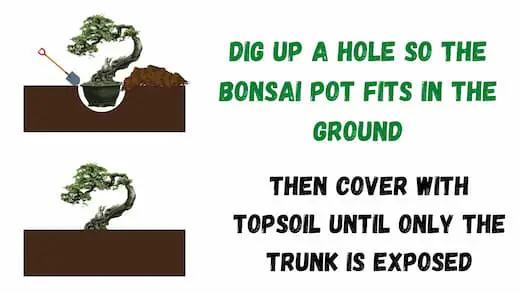
Should you use coffee grounds in your Ficus potting soil?
Ficus trees prefer neutral soil and are not particularly fond of coffee grounds which can acidify the soil. While coffee grounds can be used sparingly on Ficus, using coffee grounds too frequently can impact your Ficus’ ability to absorb nutrients from the earth.
To read up more on this – check out my post here.
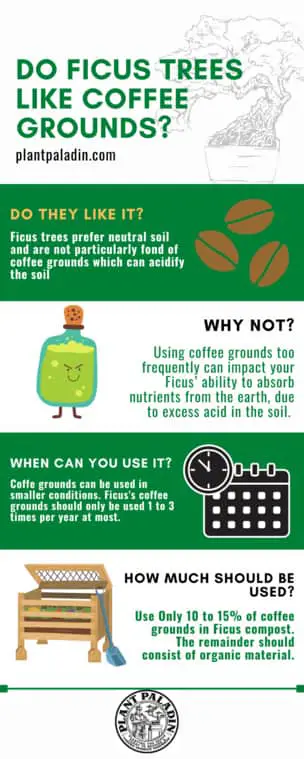
Survey on the best potting soil for Ficus bonsai
Finally, I am undertaking a quick survey of 10 plant paladin readers, asking them what the best potting solid for Ficus bonsai was.
You can find the results below:
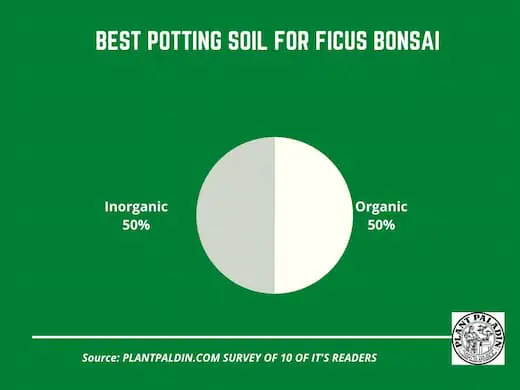
My top picks for the gear you will need!
So like I mentioned earlier, over the past three years of running PlantPaladin, hundreds of people have asked me for my recommendations on the best bonsai gear on the market.
Having spent thousands of dollars on bonsai items these past few years and tested at least 100 bonsai-specific products, I’ve listed my favorite products below – All of which I highly recommend and think you can get great value.
They can purchase directly by clicking the link to take them to Amazon.
Bonsai Tool Set: One of the significant challenges I’ve had is finding a toolset that was not only durable but didn’t break the bank. SOLIGT has recently developed a fantastic bonsai tool set that covers all the tools you need to trim, prune, and repot your trees. – You can grab it here.
Complete Bonsai Set: Many of you will want to grow your bonsai trees entirely from scratch, but finding the varicose seeds, pots, and other items in one place can be challenging. Leaves and Sole then have created a complete bonsai set that I’ve personally used that ticks all the boxes. You can grab it here.
Bonsai wire: The number of times I’ve run out of wire for my bonsai or purchased cheap bonsai wire that doesn’t do the job is embarrassing for me to admit. After a lot of trial and error, I found that using Hotop’s aluminum bonsai wire is one of the best options on the market. This can easily be used for both indoor and outdoor bonsai. You can grab it here.
This post was written by Fehed Nicass, who has been passionate about bonsai for over three years.

